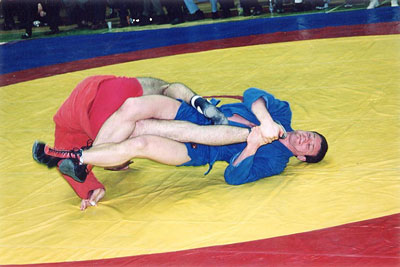 Sambo - Russia: meaning "self defense without a weapon" - Created at the instigation of Vladimir Lenin during the Bolshevik Revolution in 1918 to improve the hand-to-hand combat skills of the military and the police, the secret self-defense training eventually spread to the masses and became an official, competitive Soviet sport in 1938.
Sambo - Russia: meaning "self defense without a weapon" - Created at the instigation of Vladimir Lenin during the Bolshevik Revolution in 1918 to improve the hand-to-hand combat skills of the military and the police, the secret self-defense training eventually spread to the masses and became an official, competitive Soviet sport in 1938.
There are three FIAS recognized competitive sport variations of Sambo (though Sambo techniques and principles can be applied to many other combat sports).
Sport Sambo is stylistically similar to Olympic Freestyle Wrestling or Judo, but with some differences in rules, protocol, and uniform. For example, in contrast with judo, Sambo allows some types of leg locks, while not allowing chokeholds. It focuses on throwing, ground work and submissions, with (compared to Judo) very few restrictions on gripping and holds.
Combat Sambo utilized and developed for the military, Combat Sambo resembles modern mixed martial arts, including extensive forms of striking and grappling where (unlike Sport Sambo) choking and bent joint locks are legal. Competitors wear jackets as in sport sambo, but also hand protection and sometimes shin and head protection. The first FIAS World Combat Sambo Championships were held in 2001.
Freestyle Sambo – uniquely American set of competitive Sambo rules created by the American Sambo Association (ASA) in 2004. These rules differ from traditional Sport Sambo in that they allow choke holds and other submissions from Combat Sambo that are not permitted in Sport Sambo as well as certain neck cranks and twisting leg locks. Freestyle Sambo, like all Sambo, focuses on throwing skills and fast ground work. No strikes are permitted in Freestyle Sambo. The ASA created this rule set in order to encourage non-Sambo practitioners from judo and jiujitsu to participate in Sambo events.
In 1968, the FILA accepted Sambo as the third style of international wrestling. In 1985, the Sambo community formed its own organization, Federation International Amateur Sambo (FIAS). In 1993, FIAS split into two organizations, both used the same name and logo and the two groups were often referred to as FIAS "East" (under Russian control) and FIAS "West" (under US and Western European control). This split mirrored the last days of Cold War politics of the time as well as the recent break-up of the Soviet Union. In the U.S., disagreements between the sport's organizers and the rise of Brazilian Jiu-Jitsu in the 1990s slowed down the growth of Sambo before the success of several Sambo fighters increased its popularity a decade later.[12] In 2005, FILA reached an agreement with FIAS "West" and re-assumed sanctioning over sport Sambo. However, in 2008, FILA again discontinued sanctioning sambo and sambo is now notably missing from the FILA website.[14] At present, FIAS sanctions international competition in sport and combat sambo.
|
Below is a video about Sambo from The History Channel TV Series Human Weapon
|
|
Please refer to our references as we have used a few different sources for the basic explanation of each martial art discipline. Many of our direct links, images and text will be from the site Wikipedia which is not known for the most accurate information when it comes to doing a thesis or studying for ones P.H.D. but does have a large collection of data that is well organized. Much of the text regarding martial arts styles on Wikipedia seems to generally sum up each discipline as good as many other sources. We do not intend to re-invent the wheel, but we do want to roll you in a good direction in order to get a glimps of each style.
| References: | http://www.usgyms.net | |
| http://en.wikipedia.org | ||

